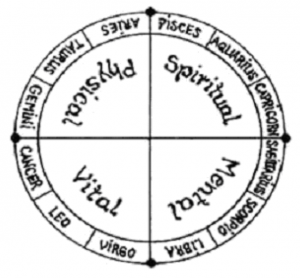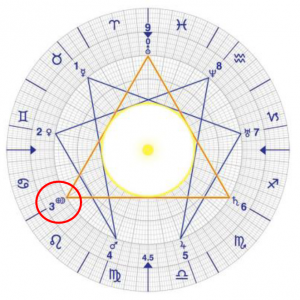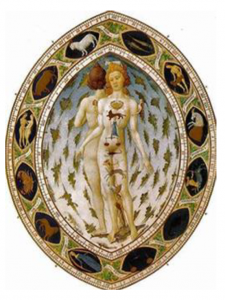Also in this Series
- The Conundrum of India’s Choice of Destiny, Part One
- The Conundrum of India’s Choice of Destiny, Part Two
- The Conundrum of India’s Choice of Destiny, Part Three
- The Conundrum of India’s Choice of Destiny, Part Four
- The Conundrum of India’s Choice of Destiny, Conclusion
The coming together of the USA and India as seen in the new cosmology is ‘destined’, how and where do we read this destiny, if at all it exists? For decades India and America have been keeping a distance imposed by the exigencies of the erstwhile Cold War; and there were certainly many reasons for India to be suspicious of America’s intentions – its close relationship with Pakistan proves that those suspicions were not without foundation. In the midst of mounting evidence of wrong-doings and pressure from the international community, to some extent America’s stance has been worn down. No doubt playing a decisive role of late has been pressure from the business community in the USA, for as we know, America will ultimately put business interests above all else. Number-power of the new cosmology helps us understand why this is so.
In reducing a given number to its seed digit by the Mathematics of Unity, we discover that the year of America’s independence reduces to 3 (1776 = 1+7+7+6=21=3). To learn in what way 3 may indicate America’s preference for business, we need to insert the number together with the full scale into a geometric design that allows number to speak to us, as it did for the Ancients. This is the Circle. There are verses from the Rig Veda that give precise instructions on how to begin the exercise of making the cosmic connection by various divisions of that ‘one wheel’,
Twelve spokes, one wheel, navels three.
Who can comprehend this?
On it are placed together
Three hundred and sixty like pegs.
They shake not in the least.
Rig Veda 1.164.48
 |
 |
Dividing the circle (wheel) into 12 parts (spokes), and 360 degrees (pegs), we know that the circle in question is the ecliptic plane where Earth and all the planets travel in their respective orbits around the Sun. These are our 12 months of the year.
To locate where the number 3 falls we see that 3 is one of the angles of the inner triangle (gold-orange colour), and that it falls in the second quarter of the wheel, the Vital. On this basis when we state that by virtue of the year of Independence, 1776, America vibrates to the number 3, the Gnostic Circle reveals where that 3 falls within the One Circle of the Veda. It is in the second quarter of the fourfold division of the ecliptic divided into 12 (spokes), for these 12 are then sub-divided into four which is called Twastri’s Bowl in the Veda; the four angles are the Cardinal Points that determine our seasons on Earth. More importantly, they are the equinoxes and solstices, the stabilising pillars that support us in Time and Space in our orbital journey; given the stability provided by these ‘pillars’, they fulfil the last line in the verses quoted above in reference to the divisions of the one circle: ‘…They shake not in the least’ – perhaps the most important lines in the quoted text.
One of the first references to the four castes is found in the Rig Veda, in X.90.11-12, known as the Purush Shukta verses; it may not be known that they have their origin in the cosmic harmony, as almost all cultural expressions on the subcontinent. As the verses explain, a part of the body is allocated to each caste; similarly, each part of the human body is said to be governed by a particular zodiacal sign. Therefore we can lay the human body along the periphery of the Circle (always the Vedic one circle), starting with Aries/Agni, the head; proceeding through the circle/body, the 12 end with Pisces and the Feet of the cosmic man. Because we are dealing always with the one circle, as prescribed by the Rig Vedic verses quoted above, each quarter of the Circle when divided in four parts covers one of the four castes, as this diagram explains.
 |
 |
The great key of knowledge passed on is that all measurements are done in the One Circle; this injunction is what allows the Vedic laws of equivalency and correspondence to be applied, on the basis of which the cosmic harmony can be read like a book. This is what India has preserved from ancient times, though today it is not a part of the study of post-Vedic Jyotish. Continuing to disregard this key results in the loss of the cosmic connection entirely.
Apart from caste in India, contemporary societies across the globe are divided into the same four major categories, though designated differently: 1) Shudra: labour, tillers of the soil, serving classes, etc, 2) Vaishya: Economics/commerce, industrialists, suppliers/traders, etc, 3) Kshatriya: Governing classes and protectors of the people, etc, and 4) Brahmin: the class that in contemporary affairs lies dormant and is sought to be replaced by the intellectual class; in point of fact, this is the quarter that has been appropriated by religions and philosophical/spiritual elements in society. It is now placed within reach of the human being only through death (heaven). However, it is neither extra-terrestrial nor extra-cosmic, but has simply been closed to the human species in attendance of the new Power the Avatar brings on Earth. In the Vedic Age this last quarter was Swar. Sri Aurobindo makes clear that there was a departure from a quest for the Vedic Swar here on Earth, via a mechanism explained in the Rig Veda very carefully. He wrote, ‘The ascent of man into heaven is not the key but rather the descent of the Spirit into his normal humanity and the transformation of his earthly nature. For that and not some post mortem salvation is the real new birth for which humanity awaits.’
With these keys of knowledge the understanding the Rishi encourages can put each thing in its rightful place;therefore, the items mentioned so far can reveal their common truth-essence and make sense out of apparently disconnected events. For example, the second quarter of the circle is the position the new India also occupies (1947=3). The business penchant holds true in both cases, India and America. However, in India the strongest influence comes via her ancient astrological ruler, Capricorn/Makar, which we can also locate in the Vedic one circle. The 3 number-power is the recent ingredient of her destiny and, while of less significance, it does carry enough weight to make it a determining factor in the joining of the two nations for the benefit of the entire globe in that the USA and India resonate to the same fields the 3 number-power embraces.
This is how we begin to see that only through an amalgam of ancient and new can the affairs of contemporary India be assessed properly. The cosmic harmony based on the Vedic one circle that ‘shakes not in the least’ is the methodology to employ. Let us examine the elements that allow us to grasp the connections between the two nations with the aid of diagrams illustrating the way the One Circle is the key.
India poses an interesting problem regarding destiny. A horoscope can be drawn up for the new India based on the exact time of Independence on 15 August 1947. However, the problem lies in the fact that there are two ‘influences’ to consider. One is seen in the new horoscope of 15 August, which places her in the second quarter at the 3 angle (1947=3); the other is Bharat’s ancient astrological ruler that dates back to prehistory, for which obviously we have neither date nor time; it is Bharat’s ancient ruler that is the thread of the Sanatana Dharma carried over into all her cultural expressions. We know from worldwide astrological tradition up to the present that India’s ruler is zodiacal Capricorn (Makar); but more importantly, this is confirmed by the sign’s own zodiacal hieroglyph, given its synchronicity with actual geographical Akhand Bharat.

This reveals the present-day conundrum Indian society faces. Which influence is to prevail? Interestingly, the destiny pattern itself established for the new India by Mahakala provides the answer. However the question to ask is who can understand, or rather, read this composite destiny, unique to India? We have no other model to turn to. Therefore an entirely new cosmology had to be revealed in order to be able to do justice to this unique circumstance of destiny. To be borne in mind is that ‘reading’ this special arrangement is the way to move into the new dispensation armed with a knowledge that can provide the required determination and strength to weather all the storms that may lie ahead.
For those unfamiliar with astrological tradition as it is practiced worldwide, the hieroglyphs corresponding to each sign, as seen in the above diagrams, are of very ancient origin, so remote that we have no record of the exact date they were first ‘seen’ and then passed into the store of higher knowledge that has survived since then. They are, as it were, a shorthand script of universal character and relevance – indeed, an eternal universal Language. Therefore, when I place before the reader the Capricorn/Makar hieroglyph superimposed on the geographical body of Akhand Bharat, the exactitude in the correspondence is awe-inspiring. Prominent in the news of late is the attempt to show how much science was known in ancient Bharat, often anticipating discoveries made only in the last century. We are familiar with the breakthroughs in mathematics and geometry, but even more interesting is the correspondence I am placing before you. How was the actual geography of the subcontinent seen in such a remote age before the airplane or the space rocket existed – or so we assume? The answer will never be found, so we can lay the question to rest. My point is that this Map/Symbol was discovered, or better unveiled, only in 1974. It plays a primary role in the new Indocentric applied cosmology because we can actually measure the spatial landmass not only on the body of the planet’s latitude coordinates, but even more importantly, we have a key to its temporal measure when we carry this over to the universal calendar via longitude coordinates. It is this symbol-map that holds the profoundest details of India’s ancient and new destiny. For that is the point: without this symbol-map we could not bring about the harmonious resolution to the conundrum: ancient or new? Nor could we appreciate the conjoint role India and America play in the new dispensation.
